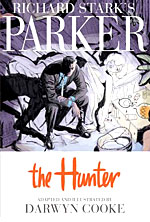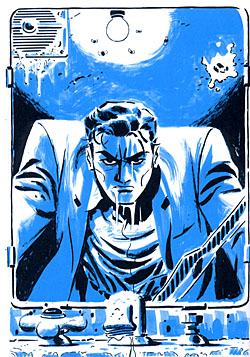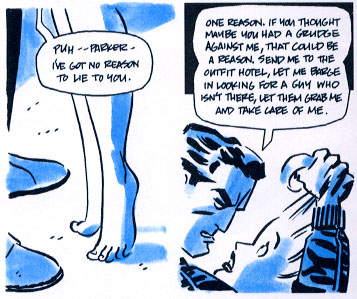 Original novel by Richard Stark
Original novel by Richard Stark
Adapted by Darwyn Cooke
144 pages, two-color
Published by IDW
Depending on how you look at it, I’m either the right or the wrong choice to review Darwyn Cooke’s adaptation of the Richard Stark novel The Hunter. Stark (a pseudonym of author Donald Westlake) was the star of no less than 24 novels, and The Hunter was adapted into two movies, Point Blank and Payback. Of those, I’ve read and seen none of them. But I love books like Ed Brubaker and Sean Phillips’s Criminal, or Jamie S. Rich and Joëlle Jones’s You Have Killed Me. And in the end, I decided, surely that must be enough to get a good read on Parker: The Hunter and see just what Darwyn Cooke ended up bringing to life in comic book form.
 It was the 1960s, and Parker had pulled off an amazing heist when one of his partners and his wife betrayed him, shooting Parker and leaving him for dead. Somehow Parker survived, but ended up in prison. Once he caught wind of where his betrayers were, though, it was time for Parker to break out and exact the revenge that’s been simmering inside of him. Step one, track them down. Step two, get the $45,000 they still owe him. Step three, revenge. Simple as that.
It was the 1960s, and Parker had pulled off an amazing heist when one of his partners and his wife betrayed him, shooting Parker and leaving him for dead. Somehow Parker survived, but ended up in prison. Once he caught wind of where his betrayers were, though, it was time for Parker to break out and exact the revenge that’s been simmering inside of him. Step one, track them down. Step two, get the $45,000 they still owe him. Step three, revenge. Simple as that.
I think I was about a dozen pages into Parker: The Hunter when I realized I was already entranced. In that brief amount of time Parker had scared drivers on a bridge (as he walked across it), jumped a subway turnstile, charmed (and then disgusted) a diner’s waitress, and had just started to forge a driver’s license. And in many ways, these pages help really define Parker in a way that sticks throughout the rest of the book. He’s single-minded, he’s driven, he has a plan, and woe to anyone who gets in the way of it. When Parker charms the waitress early on, the charm is on for only as long as it needs to. Then, the second he has what he needs, it’s business again. Parker is, ultimately, all about the business. As he threatens, punches, shoots, manipulates, and kills his way to his goal, it’s almost hard to not like him. Cooke brings a certain charm to the page when it comes to Parker, a man who really deserves every ounce of self-confidence that he continually whips out to all who think otherwise.
 At the same time, Cooke doesn’t sugarcoat the fact that Parker is not a good person at all. When innocent people die as a result of Parker’s plans, there’s no remorse evident, no sympathy. He might go so far as to call the police to let them know where the dead body is, but other than that Parker’s eyes are still on his ultimate prize. This is, after all, a professional criminal who performs all sorts of crimes whenever his bank account gets low, and who was involved in a gun-running scheme when he was betrayed and caught. Cooke doesn’t apologize for Parker’s behavior here, but instead just leaves it like it is—a man you may enjoy reading about but would absolutely never want to meet in real life. I can only assume that Cooke’s leaving Parker true to form the way he was in the original novel of The Hunter, but based on everything I’ve heard about the book (and its numerous sequels) over the years, it certainly sounds accurate to me.
At the same time, Cooke doesn’t sugarcoat the fact that Parker is not a good person at all. When innocent people die as a result of Parker’s plans, there’s no remorse evident, no sympathy. He might go so far as to call the police to let them know where the dead body is, but other than that Parker’s eyes are still on his ultimate prize. This is, after all, a professional criminal who performs all sorts of crimes whenever his bank account gets low, and who was involved in a gun-running scheme when he was betrayed and caught. Cooke doesn’t apologize for Parker’s behavior here, but instead just leaves it like it is—a man you may enjoy reading about but would absolutely never want to meet in real life. I can only assume that Cooke’s leaving Parker true to form the way he was in the original novel of The Hunter, but based on everything I’ve heard about the book (and its numerous sequels) over the years, it certainly sounds accurate to me.
As for the art, though. Oh, the art. Cooke’s black and blue art for Parker: The Hunter is drop-dead gorgeous. It’s in Cooke’s traditional animation-styed art, with streaks of blue used to give it an old-fashioned look. From perky waitresses and timid innocent bystanders, to slimy crooks and double-crossing ex-wives, everyone has their own distinct look that comes across sharply. It’s fairly impressive how Cooke can just use black and blue as his colors and create so much depth to each of the pages. As for Parker himself, Cooke waits for 15 pages until we actually see his face. Until then, it’s either glimpses of him from behind, or the focus of the panels what Parker himself is actually seeing. It’s a smart move, letting us see how people are reacting to Parker before we finally "meet" Parker himself.  When he does appear, it’s with unkempt hair, water dripping from his face, his clothes a mess. But his eyes stab out at the reader, with such grim determination and sense of purpose radiating out of them that it’s not only striking but unnerving. This is a man that you don’t mess with, under any circumstances.
When he does appear, it’s with unkempt hair, water dripping from his face, his clothes a mess. But his eyes stab out at the reader, with such grim determination and sense of purpose radiating out of them that it’s not only striking but unnerving. This is a man that you don’t mess with, under any circumstances.
From start to finish, this is a handsome book. Cooke uses some good stylistic tricks to tell his story; it’s amazing how something as simple as a slight pixilated effect on any panel containing a flashback never has to be explained but is instantly evident to the reader. And for a violent book, it’s amazing how very little violence is actually on-panel. Sometimes it’s told merely with silhouettes, other times it’s pushed off the edges of the panel with only the shrieks and screams drifting into the view of the reader telling the full story. My only complaint about the entire book is rather telling: wishing that there was an optional oversized version of the book to show off Cooke’s art even more.
When I was done reading Parker: The Hunter, my first instinct was to run out and read some Richard Stark novels. But you know what? For now I think I’m going to sit tight. The last page of Parker: The Hunter, after all, announces that "PARKER WILL RETURN IN 2010." With Cooke scheduled to adapt four of the Parker novels into graphic novels, I think I want my first exposure to them to be the Cooke versions. I had so much fun reading Parker: The Hunter that I don’t want anything to distract from it. If you like crime, thriller, or noir novels, you absolutely must buy this book. It’s set to debut in mid-July 2009, right as Comic-Con International kicks off in San Diego. I can’t blame IDW, because this is going to be one of the crown jewels of their publishing line. Highly recommended.
Purchase Links: Amazon.com | Powell’s Books
